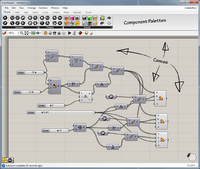
Photo from wikipedia
An end-to-end joint source–channel (JSC) encoding matrix and a JSC decoding scheme using the proposed bit flipping check (BFC) algorithm and controversial variable node selection-based adaptive belief propagation (CVNS-ABP) decoding… Click to show full abstract
An end-to-end joint source–channel (JSC) encoding matrix and a JSC decoding scheme using the proposed bit flipping check (BFC) algorithm and controversial variable node selection-based adaptive belief propagation (CVNS-ABP) decoding algorithm are presented to improve the efficiency and reliability of the joint source–channel coding (JSCC) scheme based on double Reed–Solomon (RS) codes. The constructed coding matrix can realize source compression and channel coding of multiple sets of information data simultaneously, which significantly improves the coding efficiency. The proposed BFC algorithm uses channel soft information to select and flip the unreliable bits and then uses the redundancy of the source block to realize the error verification and error correction. The proposed CVNS-ABP algorithm reduces the influence of error bits on decoding by selecting error variable nodes (VNs) from controversial VNs and adding them to the sparsity of the parity-check matrix. In addition, the proposed JSC decoding scheme based on the BFC algorithm and CVNS-ABP algorithm can realize the connection of source and channel to improve the performance of JSC decoding. Simulation results show that the proposed BFC-based hard-decision decoding (BFC-HDD) algorithm (ζ = 1) and BFC-based low-complexity chase (BFC-LCC) algorithm (ζ = 1, η = 3) can achieve about 0.23 dB and 0.46 dB of signal-to-noise ratio (SNR) defined gain over the prior-art decoding algorithm at a frame error rate (FER) = 10−1. Compared with the ABP algorithm, the proposed CVNS-ABP algorithm and BFC-CVNS-ABP algorithm achieve performance gains of 0.18 dB and 0.23 dB, respectively, at FER = 10−3.
Journal Title: Entropy
Year Published: 2022
Link to full text (if available)
Share on Social Media: Sign Up to like & get
recommendations!